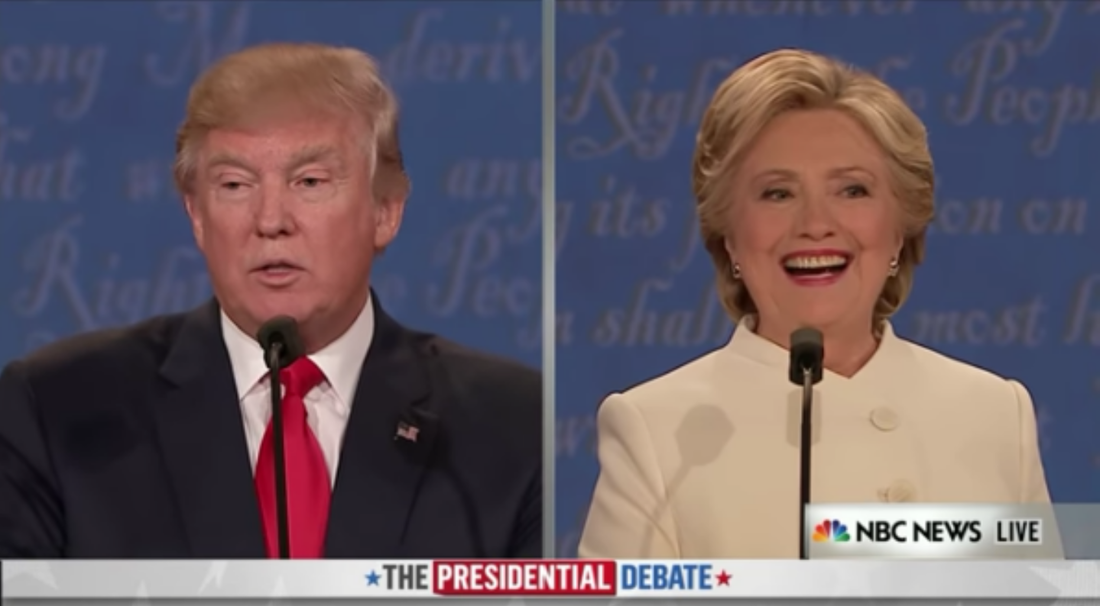1 Trump: “Very unfair that somebody runs across the border, becomes a citizen, under her plan,” ((points at Clinton, looks at audience))” you have open borders. You would have a disaster on trade…”
2 Clinton: ((Leans head back, laughs,))
3 Trump: “and you will have a disaster with your open borders.”
4 Wallace: “I want to...”
5 T: ((holds up finger)) “But what”
6 C: ((looking down)) “We will”
7 T: “she doesn't say” ((shaking hand while index finger and thumb are touching)) “is that President Obama has deported millions and millions of people just the way it is”
8 C: ((Laughs))
9 W: “Secretary Clinton, I want to...”
10 C: “We will” ((holds up hand)) “not have open borders. That is...”
11 T: ((looks at Clinton, inhales))
12 W: ((muttering)) “Well, let me -- Secretary...”
13 C: “That is a rank mischaracterization.”
14 T: ((Smiles. Interrupts inaudibly)) “Well that’s what she called for”
15 W: “Secretary Clinton...”
16 C: “We will have secure borders, but we'll also have reform.” ((gesticulates, taps hand on table)) “And this used” ((holds up hand)) “to be a bipartisan issue. Ronald Reagan--”
17 W: “Secretary Clinton, excuse me.”
18 C: “was the last president...”
19 W: “Secretary Clinton.”
20 C: “... to sign immigration reform, and George W. Bush supported it, as well.” ((flicks hand)).
21 W: “Secretary Clinton, I want to clear up your position on this issue…”
We see in this interactional regime that expectations of power of this speech community are shattered when the candidates try to fight for power and decide for themselves when to speak. It the beginning of the script, the power of over the conversation appears to lie with Trump, rather than Wallace, since he has set forth the topic of the conversation. This linguistic inequality causes the members of the debate to shift from the expectations of the speech community. In lines 12-15, all three members of the stage are speaking simultaneously. Wallace is trying to get the attention of Clinton in lines 12 and 15. Clinton defending herself from the accusations in line 13, and Trump is continuing to make verbal attacks on Clinton in line 14. It appears that all three of them are trying to forcibly make their voices heard. Wallace specifically tries to gain power of Clinton in lines 9, 12, 15, 17, 19, and 21. However, Clinton continues to speak over his interruptions. Since the most power was held by her opponent in the beginning of this section, Clinton’s choice to ignore the requests of the moderator could be due to that she recognizes the shift in power and wants to have some the control in her favor. Once the expectations of the speech community are destroyed, the moderator no longer holds power, so all members of the stage compete for it.
While Clinton is ignoring the requests of Wallace and trying to make her voice heard, she also uses non-verbal communication as a means of gaining authority. In the beginning of her defense on line 10, she holds up her hand. She does this again on line 16 when going into the next point of her statement and drawing from the experience of past presidents. It appears as if she is physically pushing away as she is interrupted by Trump and Wallace. This gesticulation could be Clinton’s way of expressing non-verbally that should would like to speak and does not care for Wallace’s attempts to regain his power. Her body language, coupled with her choice to speak, despite cues from others to listen, indicates that Clinton is trying to regain some control over the conversation after being accused by Trump, so that she has the chance to defend herself. All types of communication are used by the stage members in a struggle for power and to have their voices heard.
Once the expectations of power within this interactional regime are destroyed by shifts in power away from the moderator, the stage members fight for the ability to have control over the conversation. Once Trump maintains power over the conversation, Clinton tries to take the authority away from her opponent using verbal and non-verbal communication. As a candidate, she is expected to listen to the moderator and allow him to have power over the conversation, but refuses to do so after power shifts in favor of her opponent.
References
Friedman, G. (2012, October 24). The Purpose of Presidential Debates. Retrieved from
https://www.stratfor.com/weekly/purpose-presidential-debates
Ansfield, M. E. (2007, May 4). Smiling When Distressed: When a Smile Is a Frown Turned Upside Down. Retrieved November 01, 2016, from http://psp.sagepub.com/content/33/6/763.short
Natalie is a student in the introductory sociolinguistics course at Swarthmore College.

 RSS Feed
RSS Feed